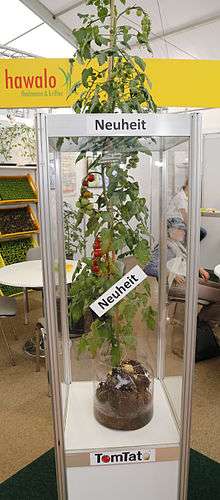Pomato

The pomato (or tomtato) is produced by grafting together a tomato plant and a potato plant, both of which are members of the Solanaceae (nightshade) family. Cherry tomatoes grow on the vine, while white potatoes grow in the soil from the same plant.[1]
Background
The concept of grafting related potatoes and tomatoes so that both are produced on the same plant was originally developed in 1977 at the Max Planck Institute for Developmental Biology in Tübingen, Germany, and although healthy, the plant produced neither potatoes nor tomatoes.[2] The Max Planck Institute for Plant Breeding Research in Cologne produced a plant with fruit in 1994.[2]
As with all grafts, this plant will not occur in nature and cannot be grown from seed, because the two parts of the plant remain genetically separate, and only rely on each other for nourishment and growth. Like most standard types of plant grafting, a small incision is made in the stem of both plants and they are strapped together. Once the cuts have healed and the plants are joined, the leafy top of the potato plant can be cut away and the roots of the tomato can be removed, leaving the leaves of the tomato plant to nourish the roots of the potato plant.[3] The rootstock (potato) acts as a stable and healthy root system and the scions (tomato) are chosen for their fruit, flowers or leaves. The tomatoes should be ready to harvest after about 12 weeks during the summer months, the potatoes should be ready after the tomato leaves begin to die back, normally in early autumn.[4] Grafting in this way can be used to produce many different related crops from the same plant, for example the growing popularity of 'Fruit salad' trees, which is a single tree that produces multiple types of citrus fruits, or a tree with a variety of fruits with stones (peach, plum etc.).[5]
Benefits
Pomato plants have been seen as a new technology to make food production more efficient, as they maximize the amount of crops that can be produced on a piece of land or in a small urban environment like a balcony.[6] This has significant impacts on developing countries like Kenya, where farmers can save on space, time and labour without affecting the quality of their produce by growing pomato plants.[7] In addition, grafting can improve resistance to bacteria, viruses and fungi, attract a more diverse group of pollinators and provide a sturdy trunk for delicate ornamental plants.[5]
Commercial products
Grafted pomato plants were launched in the United Kingdom in September 2013 by horticultural mail order company Thompson & Morgan, who sold pre-grafted plants branded as the "TomTato". The Incredible Edible nursery in New Zealand announced a "DoubleUP Potato Tom" in the same month.[8] Thompson & Morgan claim that this is the first time the plant has been produced commercially, and director Paul Hansord describes originating the tomtato idea himself 15 years ago in the US, when visiting a garden where someone had planted a potato under a tomato as a joke.[9]
Grafting is a difficult process because the tomato and the potato stems have to be the same thickness, and Thompson & Morgan trialled the hybrid for several years before selling it. Production and grafting of tomtatos begins in a specialist laboratory in the Netherlands, before being shipped back to the UK and grown in greenhouses until they are ready to be sold.[10]
Interesting facts
- In the famous 1967 Soviet novel "The Life and Extraordinary Adventures of Private Ivan Chonkin" one of the main characters, Kuzma Gladishev, an autodidact, spends his life trying to graft a hybrid, that would have "potato tubers and tomato fruits". Colleagues call his efforts "antiscientific and unpromising".
References
- ↑ Greene, David (27 September 2013). "TomTato Is The Latest Wonderplant". NPR News. Retrieved 30 September 2013.
- 1 2 Renneberg, Reinhard (2008). Biotechnology for Beginners. Elsevier. p. 210. ISBN 9780123735812.
- ↑ "How to create a pomato plant". Retrieved 29 May 2013.
- ↑ "Pomato Plants". The Guru (36). 2010. Retrieved 29 May 2013.
- 1 2 Jabr, Ferris. "The Science of Pomato Plants and Fruit Salad Trees". Scientific America. Retrieved 29 May 2013.
- ↑ "Kenyan farmers produce 'pomato' plants to improve land use". Retrieved 29 May 2013.
- ↑ "Prison grows unique 'pomato' to fight hunger". www.businessdailyafrica.com. Retrieved 29 May 2013.
- ↑ Jude Gillies. "Potato Tom opens fresh doors". Stuff.co.nz. Retrieved 2013-09-30.
- ↑ Hall, John (27 September 2013). "The TomTato: Plant which produces both potatoes and tomatoes launched in UK". The Independent. Retrieved 30 September 2013.
- ↑ Wilkes, David (25 September 2013). "The TomTato... or how you can make ketchup AND chips from the same plant! |". Mail Online. Retrieved 30 September 2013.